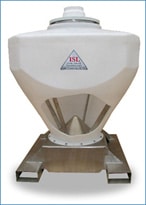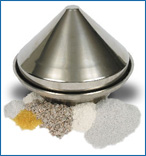 The ‘rolling seal’ actuator, together with a transducer, provides high-accuracy, gravimetric powder handling, process control, and powder and particulate flow-control, and also allows – if required – an accurate weighing capability of stored products into further process or final packing. The key attributes of the ‘rolling seal’ discharge station are:
The ‘rolling seal’ actuator, together with a transducer, provides high-accuracy, gravimetric powder handling, process control, and powder and particulate flow-control, and also allows – if required – an accurate weighing capability of stored products into further process or final packing. The key attributes of the ‘rolling seal’ discharge station are:
- Fast response actuation, allowing fine control of product flow
- No flow restriction
- Hygienic design, manufactured from a handful of components
- Ease of maintenance and cleaning
- Two to three-minute remove and replace for seal and covers
- Two-year guarantee on the life of the rolling seal
 CHEMICAL INDUSTRY BIG BAG DISCHARGE EQUIPMENT:
CHEMICAL INDUSTRY BIG BAG DISCHARGE EQUIPMENT:
The FIBCs (bulk bag) to be used directly in process with dust containment, batch and continuous weighing direct from the FIBC, and also has the unique ability to take a partly-empty bulk bag off process without untying or retying of the outlet, or fitting of additional components to the outlet sock, thus maintaining product containment.‘big bag bin’ with cone-valve technology can be used for the dust free discharge of FIBCs, big bags, bulk bags and sacks.
 CHEMICAL INDUSTRY SILO VALVES:
CHEMICAL INDUSTRY SILO VALVES:
There are two types of silo valves: the dosing valve and the bridge breaker. The bridge breaker is usually used with the dosing valve in tandem; the dosing valve at the silo outlet and the bridge breaker is fixed with its cross frame some distance above inside the silo hopper.The bridge breaker provides head load protection to the dosing valve, which in turn controls the discharge and accurate dosing to process. The bridge breaker can have an optional internal vibrator for more cohesive products.A major benefit of the ISL silo valve system is that the dosing valve can be dismantled from below, leaving the cone-valve assembly in place even with a full silo.
cone-valve technology can be used for powder hadling and process control of powders, granules and particulates across a wide range of chemical processing industries.
